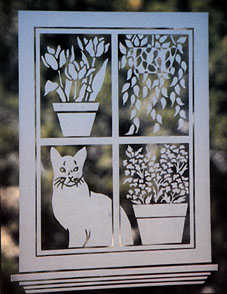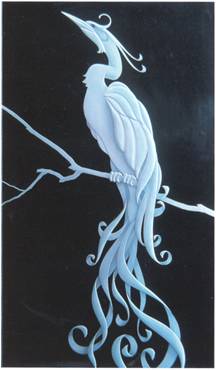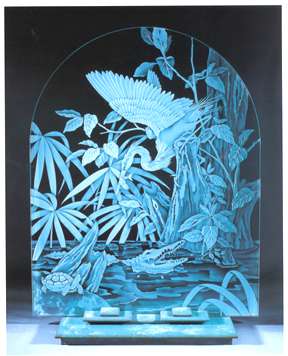|
What
different glass etching techniques are there?
All of the possible
visual effects you can achieve by abrasive blasting on glass can
be broken down into 3 major techniques: surface etching,
carving and shading.
|
Surface
etching: So named because you are only etching
the surface of the glass. In addition, this type of etching
is all done in one stage of blasting, which means that the
designs produced are all 2 element designs. That is, all the
designs are positive and negative, or black and white.
The etched
portions of the design almost always look white, and the clear,
unetched portions of the design look black or dark. All etched
elements have to be separated by spaces of unetched glass,
or the etched elements blend together as a single silhouette,
with no detail inside the border.
Surface
etching is the easiest technique to learn and the fastest
way to produce a finished etching on glass. The etched designs
aren't as sophisticated as those from carving or shading.
|

Surface
etching produces a frosted design on an otherwise clear piece
of glass.. (Etched window created by Norm & Ruth Dobbins,
of Professional Glass Consultants. Pattern by Debra Oxley,
available in Design Book 1, and Glass Etching: Surface
Techniques & Designs, used by permission.)
|
Carving:
Called carving because you actually blast, or carve, deep into the
glass, giving a three dimensional etching. There are several types
of carving, including single stage, two stage, multi-stage, and
freehand carving. Single stage carving is simply blasting a surface
etching design deeply into the glass, separating elements with clear
spaces, as in surface etching. With two stage or multi-stage carving,
the resist is removed, not all at once, but a few elements at a
time and in a definite sequence. This way, elements can be carved
to different depths than the other elements they touch, yielding
a 3-D bas relief carving. But not a regular bas relief, a reverse
bas relief - since you are carving from one side of the glass and
viewing the finished carving from the opposite (smooth) side! In
other words, you are carving a hollow (or negative) shape in the
glass that looks solid and positive from the smooth side.
|
Elements
of a two stage or multi-stage carving design do not have to
be separated from each other as they do in surface etching,
because they are removed at different times and blasted to
different depths. These different depths are what give the
necessary visual separation between elements.
In
the multi-stage carved bird at right, you can easily see that
all the elements in the design touch each other (without the
artificial clear spaces between each element). You can easily
see the edges of each element because the elements are carved
to different depths where they touch. (Design and execution
by Wally Zampa, Zampa Art Glass; from Glass Etching: Techniques
& Designs, used by permission of the publisher)
|
 |

A combination
of multi-stage shading and multi-stage carving is used in this
piece. The shading is obvious because the elements are different
shades of gray, especially where they touch.(Design
and execution by Heather
Mathews, Heather Glass; from Glass
Etching: Techniques & Designs, used by permission of
the publisher) |
Shading:
Like surface etching, this technique just blasts the surface
of the glass. But unlike surface etching, the elements in the
design are blasted to different apparent shades of gray (hence
the name Shading), rather than to the solid white color produced
in surface etching. The principle of shading is that 100% clear
glass usually appears dark while full surface etching appears
100% white. So you can create shades of gray by etching the
surface to a density less than 100%, and you control the shade
by controlling the density. Shading, like carving, can be done
in one stage, two stage, multi-stage, and freehand techniques.
|
Elements of
the shading design can all touch, as they can with a carving design,
because the visual separations between elements are created by the
stage blasting process. In shading, this gives different shades
of gray where elements touch rather than different depths as in
carving. Shaded etching looks very much like airbrushing, with flowing
tones of light and dark indicating shape and contour.
Combinations
of techniques: Any etching can be produced with just
one technique, but also by a combination of two or all three techniques.
For glass etchers who know all three techniques, this gives the
ability to do the best and most sophisticated etchings possible.
It is the ability to use each technique for its strengths and avoid
its weaknesses. You can also get beautiful results by combining
etching with other glassworking techniques, like stained glass,
glass blowing, etc.
|





